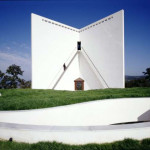Argentinian architect Emilio Ambasz, a part-time resident of the Principality of Monaco, has won the President’s Award at the New York-based Consortium for Sustainable Urbanization.
Described as “one of the greatest international masters of design and architecture” as well as being an established inventor with more than 220 industrial and mechanical patents to his name, 79-year-old Emilio Ambasz has dedicated his working life to green architecture.
He was handed the prestigious President’s Award by the Consortium for Sustainable Urbanization’s president and founder, Lance Jay Brown, during a gala evening event at the Century Association in New York City on 23rd March. In essence, the award is an international recognition of Ambasz’s “commitment to the fields of sustainable, responsible and resilient urbanisation, planning and design”.
In a speech, Brown highlighted some of Ambasz’s most remarkable and stand-out creations over the years, such as the Casa de Retiro Espiritual in Seville, the Arcos Centre in Fukuoka and the Lucile Halsell Conservatory in Texas.
He also spoke of Ambasz’s enduring philosophy of “green over grey” and his unique interpretation of the relationship between architecture and nature.
A man of “great influence”
“Emilio Ambasz continues to be of great influence,” said Brown. “For over 50 years, he has exemplified the capacity of design to work across disciplines and industries and to positively influence the environment we inhabit. This has been done intellectually, philosophically, and kinetically by his many and varied activities. He was so early to integrating sustainable architecture, urban design, and landscape architecture that most were not yet ready to appreciate the profundity of his work. The Consortium for Sustainable Urbanization is both privileged and pleased to honor him with this recognition.”
Left to right (click to enlarge): Casa de Retiro Espiritual in Seville, the Arcos Centre in Fukuoka and the Lucile Halsell Conservatory in Texas
The pioneering architect also shared some inspirational words with those gathered: “Every building is an intrusion into the plant kingdom and is a challenge to nature: we must devise architecture that stands as the embodiment of a reconciliatory pact between nature and construction, designing buildings so intrinsically connected to their surroundings that they are unable to disentangle themselves from each other.”
Ambasz spends part of his year living in Monaco. In the late 1990s, he came close to producing a vast land extension project in the Port of Monaco – a mainly residential and hospitality concept featuring lake, parks and the construction of a dam to add five hectares of land to the Principality – but it wasn’t to be.
Sign up for the Monaco Life newsletter. For the latest news, follow us on Facebook, Twitter, and Instagram.
Photo by Wade Zimmerman




